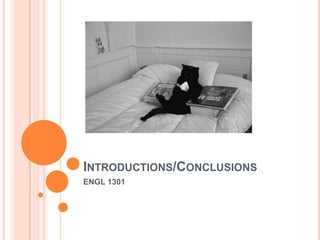
Introductions/conclusions
- 2. INTRODUCTION The introduction should be designed to attract the reader's attention and give her an idea of the essay's focus. Begin with an attention grabber.The attention grabber you use is up to you, but here are some ideas:
- 3. Startling information This information must be true and verifiable, and it doesn't need to be totally new to your readers. It could simply be a pertinent fact that explicitly illustrates the point you wish to make. If you use a piece of startling information, follow it with a sentence or two of elaboration.
- 4. Anecdote An anecdote is a story that illustrates a point. Be sure your anecdote is short, to the point, and relevant to your topic. This can be a very effective opener for your essay, but use it carefully.
- 5. Dialogue An appropriate dialogue does not have to identify the speakers, but the reader must understand the point you are trying to convey. Use only two or three exchanges between speakers to make your point. Follow dialogue with a sentence or two of elaboration.
- 6. Summary Information A few sentences explaining your topic in general terms can lead the reader gently to your thesis. Each sentence should become gradually more specific, until you reach your thesis. If the attention grabber was only a sentence or two, add one or two more sentences that will lead the reader from your opening to your thesis statement. Finish the paragraph with your thesis statement.
- 7. SAMPLE INTRODUCTION Stephen King, creator of such stories as Carrie and Pet Sematary, stated that the Edgar Allan Poe stories he read as a child gave him the inspiration and instruction he needed to become the writer that he is. Poe, as does Stephen King, fills the reader's imagination with the images that he wishes the reader to see, hear, and feel. His use of vivid, concrete visual imagery to present both static and dynamic settings and to describe people is part of his technique. Poe's short story "The Tell-Tale Heart" is a story about a young man who kills an old man who cares for him, dismembers the corpse, then goes mad when he thinks he hears the old man's heart beating beneath the floor boards under his feet as he sits and discusses the old man's absence with the police. In "The Tell-Tale Heart," a careful reader can observe Poe's skillful manipulation of the senses.
- 8. CONCLUSION The conclusion brings closure to the reader, summing up your points or providing a final perspective on your topic. All the conclusion needs is three or four strong sentences which do not need to follow any set formula. Simply review the main points (being careful not to restate them exactly) or briefly describe your feelings about the topic. Even an anecdote can end your essay in a useful way.
- 9. THE CONCLUSION SHOULD: Stress the importance of the thesis statement, Give the essay a sense of completeness, and Leave a final impression on the reader.
- 10. FINALLY Answer the question "So What?" Show your readers why this paper was important. Show them that your paper was meaningful and useful. Synthesize, don't summarize Don't simply repeat things that were in your paper. They have read it. Show them how the points you made and the support and examples you used were not random, but fit together. Redirect your readers Give your reader something to think about, perhaps a way to use your paper in the "real" world. If your introduction went from general to specific, make your conclusion go from specific to general. Think globally. Create a new meaning You don't have to give new information to create a new meaning. By demonstrating how your ideas work together, you can create a new picture. Often the sum of the paper is worth more than its parts.